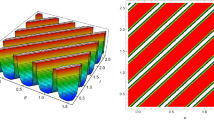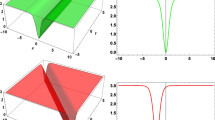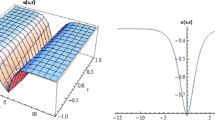Abstract
In this paper, we introduced a new dual-mode nonlinear Schrödinger (DMNLS) equation with nonlinearity Kerr of types square-root law and dual-power law. The new model consists of three parameters defined as dissipative, nonlinearity and the phase velocity. Also, this model describes propagations of two simultaneously directional waves instead of single wave as in the standard Schrödinger model. We determined the necessary conditions on the dissipative nonlinearity parameters that produce soliton solutions of DMNLS. Finally, a graphical analysis regarding the effect of the phase velocity on the shapes of the obtained dual-waves is accomplished.
Similar content being viewed by others
Explore related subjects
Discover the latest articles, news and stories from top researchers in related subjects.Avoid common mistakes on your manuscript.
1 Introduction
Recently, a new family of nonlinear equations under the name “two-mode” or “dual-mode” have been established. The members of this family are nonlinear partial differential equations of second order in the time coordinate. It describes the propagations of two different nonlinear wave modes simultaneously. The KdV equation of second order in time was the first established two-mode equation [1, 2]
where \(u=u(x,t)\) is a field function, s the interaction phase velocity, \(\alpha \) the nonlinearity factor, and \(\beta \) the dispersive factor with \(s\ge 0\), \(|\alpha | \le 1\), \(|\beta | \le 1\), and we refer to Eq. (1.1) as the two-mode KdV equation (TMKdV). The TMKdV has been constructed as a related topic to Hirota–Satsuma model [3], which describes the interaction of two long waves with different dispersion factors and concluded that if there is no interaction between these two waves, no effect of one wave on the other, then these waves obey the KdV equations. Indeed, if \(s=0\) in (1.1) “no interaction” and integrating once with respect to the time t, we get the standard KdV equation
Inspired by TMKdV (1.1), Korsunsky and Wazwaz [1, 4] suggested a two-mode generator learned as follows. Any nonlinear equation obeys the form
where \(N,\ L\) are, respectively, the nonlinear and linear operators. Then, the two-mode version of (1.3) takes the form
Consequently, some new real-valued two-mode models are established [5,6,7,8,9,10,11,12] and soliton–kink, multiple soliton–kink solutions are obtained to these models by applying simplified Hirota and tanh-expansion methods. The contributions on two-mode equations conducted in the aforementioned studies were limited to extract only solitary wave solutions restricted with some constraint conditions. Motivated by the existing literature, there was only one attempt to extend the two-mode concept on complex-valued model. In [13], a two-mode Schrödinger (TMNLS) with power Kerr law is established and both dark and singular soliton solutions are obtained. Therefore, we aim to further explore TMNLS with different types of the Kerr laws and conduct some graphical justifications.
The nonlinear Schrödinger (NLS) is a physical model that plays a key role in engineering sciences, dynamics and nonlinear optics. The general form of NLS reads [14,15,16,17]
where the function F is the nonlinearity Kerr function and q is a complex-type envelope function. In this context, we consider two types of F: the square-root law when \(F(\tau )=\sqrt{\tau }\) and the dual-power law when \(F(\tau )=\tau + v \tau ^2\).
Now, by means of Eqs. (1.3) and (1.4), the generalized dual-mode Schrödinger is second order in time and has the form
The dual-mode (1.6) (DMNLS) models the spread of directional absorption or amplification of dual-wave pulses with distributed dispersion and nonlinearity and interaction phase velocity. We aim to study the dynamics of DMNLS for two types of the real-valued algebraic function F. The square-root Kerr
and the dual-power Kerr
Equation (1.7) is used to study soliton turbulence, and Eq. (1.8) describes the interaction between Langmuir waves and electrons [18].
Multiplicative of the dual-waves obtained for the real part of q(x, t) (2.6) by increasing the phase velocity: \(s=0.5,\ 1,\ 2,\ 3\) respectively
2 Dual-mode Schrödinger with square-root Kerr
The envelope function \(q=q(x,t)\) in (1.7) is of complex-valued type, so we may write q as
where \(\eta =\lambda (x+w t)\) and \(\zeta =x- c t\). Substituting (2.1) in (1.7) and separating real and imaginary parts will lead us to a system of two differential equations with p being the dependent real-valued function and \(\zeta \) the independent variable
Now we seek solutions to the above system by employing two methods: the tanh-expansion and the Kudryashov expansion schemes.
2.1 Tanh-solution I
The tanh-scheme suggests the solution of (2.2) to be of the form
where \(Y=\tanh (\mu \zeta )\) and satisfies the followings relations
Balancing the terms \(p^2\) and \(p''\) or \(p p'\) and \(p'''\) gives \(n=2\) in (2.3). We insert (2.3) and (2.4) in (2.2) and collect coefficients of the same power of Y. Setting each obtained coefficient to zero will produce a nonlinear algebraic system in the unknowns \(a_0,\ a_1,\ a_2,\ \lambda ,\ \mu ,\ w\) and c. By solving this algebraic system, we obtain the following outcomes
Therefore, the tanh-solution of DMNLS with square-root Kerr law (1.7) is given by
Graphical analysis regarding (2.6) reveals that the increase in the phase velocity is accompanied by a clone of the dual-waves in a multiplicative manner, see Fig. 1.
Behaviors of dual-waves obtained for the real part of q(x, t) (2.14) by increasing the phase velocity: \(s=1,\ 2,\ 3\), respectively
2.2 Kudryashov solution I
We aim to apply Kudryashov expansion technique [19, 20] to study more possible solutions to (1.7). This scheme suggests the solution of (2.2) as a polynomial of the variable Y
The variable Y satisfies the differential equation
Solving (2.8) gives
The index n is to be determined by applying order balance procedure which is in our case \(n=2\), and accordingly, we write (2.7) as
Differentiating both (2.8) and (2.10) implicitly leads to
and
Now, we insert (2.8) through (2.12) in (2.2) to get a polynomial in Y. By setting each coefficient of \(Y^i\) to zero, a nonlinear algebraic system is obtained. Seeking a solution to this system, we get
Therefore, a new solution of DMNLS (1.7) is
Figure 2 presents the behavior of the dual-waves for the real part of (2.14) when \(s=\ 1,\ 2,\ 3\), respectively.
3 Dual-mode Schrödinger with dual-power Kerr
We follow the same steps considered in the preceding section. Substituting (2.1) in (1.8) produces the system
Multiplicative of the dual-waves obtained for the real part of q(x, t) (3.6) by increasing the phase velocity: \(s=0.1,\ 1,\ 3,\ 5\), respectively
We solve (3.1) by applying the tanh-technique. Considering the suggested solution given in (2.3) and performing the balance step, we get \(m=\frac{1}{2}\) which is not applicable for the tanh-scheme. Therefore, we introduce the following new transformation
Now we replace \(p(\zeta )\) in (3.1) by \(f(\zeta )\) to retrieve a new system
The tanh-solution of this new system is
2D profile solutions for the DMNLS with dual-power Kerr law obtained in (3.6)
Y is defined as in (2.4). Inserting (3.4) in (3.3) and performing the algebraic computations, we arrive at the following results
Accordingly, the tanh-solution of DMNLS with dual-power Kerr law (1.8) is given by
3D plots of the real part of the obtained solution (3.6) asserts the multiplicative phenomena by gradually increasing in the phase velocity, see Fig. 3.
4 Conclusion
A new dual-mode Schrödinger (DMNLS) equation with nonlinearity Kerr laws of types square-root and dual-power is introduced for the first time. The new model describes the propagation of two different waves with embedded interaction phase velocity. Solitary dual-wave solutions are obtained to DMNLS equation by means of two different schemes: the tanh-expansion and Kudryashov expansion techniques.
3D plots of the obtained solutions are provided. Also, we studied geometrically the impact of the phase velocity on the interaction between the obtained dual-waves and concluded an intersecting physical phenomenon: doubling the number of these obtained dual-waves by increasing the phase velocity within the same coordinates region.
To study the formality and nature of the resulting waves of this model, we consider 2D profile solutions for the dual-power Kerr law depicted in (3.6) and conclude that both waves have the same shape and we may refer to these two waves as right-wave and left-wave as shown in Fig. 4.
The insights of the current work’s findings can be linked to the development of transmitting data through telecommunication integrated systems. The phenomenon of doubling the dual-waves may be used as a carrier wave of certain data transmitted to different directions.
References
Korsunsky, S.V.: Soliton solutions for a second-order KdV equation. Phys. Lett. A. 185, 174–176 (1994)
Lee, C.T.: Multi-Soliton Solutions of the Two-mode KdV. Ph.D. thesis Oxford University, Oxford (2007)
Hirota, R., Satsuma, J.: Soliton solutions of a coupled Korteweg-de Vries equation. Phys. Lett. A. 85(8–9), 407–408 (1981)
Wazwaz, A.M.: Multiple soliton solutions and other exact solutions for a two-mode KdV equation. Math. Methods Appl. Sci. 40(6), 1277–1283 (2017)
Xiao, Z.J., Tian, B., Zhen, H.L., Chai, J., Wu, X.Y.: Multi-soliton solutions and Bucklund transformation for a two-mode KdV equation in a fluid. Waves Random Complex Media 31(6), 1–4 (2016)
Syam, M., Jaradat, H.M., Alquran, M.: A study on the two-mode coupled modified Korteweg-de Vries using the simplified bilinear and the trigonometric-function methods. Nonlinear Dyn 90(2), 1363–1371 (2017)
Jaradat, H.M., Syam, M., Alquran, M.: A two-mode coupled Korteweg-de Vries: multiple-soliton solutions and other exact solutions. Nonlinear Dyn 90(1), 371–377 (2017)
Alquran, M., Jaradat, H.M., Syam, M.: A modified approach for a reliable study of new nonlinear equation: two-mode Korteweg-de Vries–Burgers equation. Nonlinear Dyn. 91(3), 1619–1626 (2018)
Lee, C.C., Lee, C.T., Liu, J.L., Huang, W.Y.: Quasi-solitons of the two-mode Korteweg-de Vries equation. Eur. Phys. J. Appl. Phys. 52, 11–301 (2010)
Zhu, Z., Huang, H.C., Xue, W.M.: Solitary wave solutions having two wave modes of KdV-type and KdV-burgers-type. Chin. J. Phys. 35(6), 633–639 (1997)
Wazwaz A.M., Two-mode Sharma-Tasso-Olver equation and two-mode fourth-order Burgers equation: multiple kink solutions. Alex. Eng. J. (2017). https://doi.org/10.1016/j.aej.2017.04.003
Hong, W.P., Jung, Y.D.: New non-traveling solitary wave solutions for a second-order Korteweg-de Vries equation. Z. Naturforsch. 54a, 375–378 (1999)
Jaradat, I., Alquran, M., Momani, S., Biswas, A.: Dark and singular optical solutions with dual-mode nonlinear Schrödinger’s equation and Kerr-law nonlinearity. Optik 172, 822–825 (2018)
Biswas, A.: Quasi-stationary non-Kerr law optical solitons. Opt. Fiber Technol. 9(4), 224–259 (2003)
Triki, H., Biswas, A.: Dark solitons for a generalized nonlinear Schrödinger equation with parabolic law and dual-power law nonlinearities. Math. Methods Appl. Sci. 34(8), 958–962 (2011)
Seadawy, A.R., Lu, D.: Bright and dark solitary wave soliton solutions for the generalized higher order nonlinear Schrödinger equation and its stability. Results Phys. 7, 43–48 (2017)
Biswas, A., Asma, M., Alqahtani, R.T.: Optical soliton perturbation with Kerr law nonlinearity by Adomian decomposition method. Optik 168, 253–270 (2018)
Biswas, A.: Theory of non-Kerr law solitons. Appl. Math. Comput 153, 369–385 (2004)
Kudryashov, N.A.: One method for finding exact solutions of nonlinear differential equations. Commun. Nonlinear Sci. Numer. Simul. 17(6), 2248–2253 (2012)
Wang, L., Shen, W., Meng, Y., Chen, X.: Construction of new exact solutions to time-fractional two-component evolutionary system of order \(2\) via different methods. Opt. Quantum Electron. 50, 297 (2018)
Author information
Authors and Affiliations
Corresponding author
Ethics declarations
Conflict of interest
The authors declare that there is no conflict of interests regarding the publication of the paper.
Additional information
Publisher's Note
Springer Nature remains neutral with regard to jurisdictional claims in published maps and institutional affiliations.
Rights and permissions
About this article
Cite this article
Alquran, M., Jaradat, I. Multiplicative of dual-waves generated upon increasing the phase velocity parameter embedded in dual-mode Schrödinger with nonlinearity Kerr laws. Nonlinear Dyn 96, 115–121 (2019). https://doi.org/10.1007/s11071-019-04778-0
Received:
Accepted:
Published:
Issue Date:
DOI: https://doi.org/10.1007/s11071-019-04778-0








